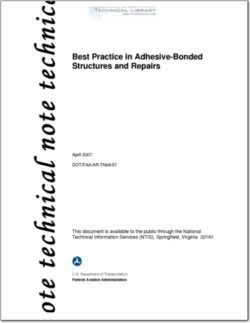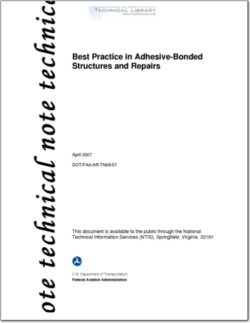DOT-FAA-AR-TN06-57

- Version
- 450 Downloads
- 2.22 MB File Size
- 1 File Count
- March 24, 2016 Create Date
- March 24, 2016 Last Updated
Best Practice in Adhesive Bonded Structures and Repairs

The opinions expressed in this technical note were presented at the Federal Aviation
Administration (FAA) Bonded Structures Workshop in 2004. The FAA, realizing their value,
commissioned a written record of these observations and recommendations. These observations
and recommendations represent the experiences, some anecdotal, in the application and
maintenance of bonded structures for one group. This document does not represent a
comprehensive survey and analysis of the failures nor best corrective actions for bonded
structures, but data that resulted from real—world applications and experience with disbonds and
other adhesive failures in structural applications.
This professional assessment of important factors in adhesive-bonding technology is based on
the author’s personal experience of more than 32 years with adhesive-bonded structures and
development of adhesive-bonded repair technology. Initial research activities were directed at
the Australian crack-patching technology that relied upon adhesively bonded composite patches
to arrest or inhibit crack growth in metallic structures. The bonding technology was then adapted
for bonded repairs to sandwich structures, principally on F-l 11 aircraft. That application led to a
reduction of the repeat-repair rate from over 42 percent in 1992 to only two known bonded-
repair failures since that date. During that time, the author also developed skills in forensic
assessment of adhesive-bond failures, leading to an understanding of the relationship between
process deficiencies and service defects.
Many of the insights presented in this technical note on adhesive bonding are the result of dialog
between various international regulators and defense customers of aviation applications for this
manufacturing and repair process. These insights were coordinated by The Technical
Cooperation Program (TTCP) that has shared various design and continued airworthiness issues
of products using bonded structures. The TTCP, headed by the late John W. (Jack) Lincoln
produced a preliminary treatise on the subject, Certification of Bonded Structures, prepared by
Action Group 13 of the TTCP. The Federal Aviation Administration (FAA) has initiated further
work to establish certification requirements for adhesively bonded structure.
| File | Action |
|---|---|
| DOT-FAA-AR-TN06-57 Best Practice in Adhesive Bonded Structures and Repairs.pdf | Download |
Comment On This Post